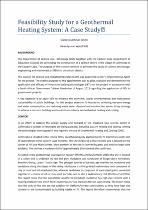JavaScript is disabled for your browser. Some features of this site may not work without it.
- ResearchSpace
- →
- Research Publications/Outputs
- →
- Book Chapters
- →
- View Item
| dc.contributor.author |
Lutchman, Stanley

|
|
| dc.contributor.author |
Van Wyk, Llewellyn V

|
|
| dc.date.accessioned | 2019-04-03T09:18:51Z | |
| dc.date.available | 2019-04-03T09:18:51Z | |
| dc.date.issued | 2019-03 | |
| dc.identifier.citation | Lutchman, S. and Van Wyk, L.V. 2018. Feasibility study for a geothermal heating system: A case study. The Green Building Handbook South Africa, Volume 12. The Essential Guide, pp. 48-53 | en_US |
| dc.identifier.isbn | 978-0-620-45240-3 | |
| dc.identifier.uri | https://issuu.com/alive2green/docs/green_building_web | |
| dc.identifier.uri | http://hdl.handle.net/10204/10921 | |
| dc.description | Chapter published in The Green Building Handbook South Africa, Volume 12. The Essential Guide, pp. 48-53 | en_US |
| dc.description.abstract | The Department of Science and Technology (DST) together with the Eastern Cape Department of Education (ECDOE) are co-funding the construction of a science centre in the village of Cofimvaba in the Eastern Cape. The purpose of the science centre is to promote the study of science, technology, engineering and mathematics (STEM) in the school district. The Council for Science and Industrial Research (CSIR) was appointed as DST’s Implementing Agent for the project. The express purpose of this appointment was to pilot, evaluate and demonstrate the application and efficacy of innovative building technologies (IBTs) on the project in accordance with a South African Government Cabinet Resolution of August 2013 regarding the application of IBTs in government projects. A key objective is to apply IBTs to enhance the economic, social, environmental and institutional sustainability of public buildings. For this project attention is focused on achieving net-zero energy and water consumption, and reducing waste water disposal and construction waste. A key strategy to achieve a net-zero building was to eliminate reliance on mechanical heating and cooling. | en_US |
| dc.language.iso | en | en_US |
| dc.publisher | Alive2Green | en_US |
| dc.relation.ispartofseries | Worklist;22256 | |
| dc.subject | Innovative building technologies | en_US |
| dc.subject | IBTs | en_US |
| dc.subject | Geothermal heating systems | en_US |
| dc.title | Feasibility study for a geothermal heating system: A case study | en_US |
| dc.type | Book Chapter | en_US |
| dc.identifier.apacitation | Lutchman, S., & Van Wyk, L. V. (2019). Feasibility study for a geothermal heating system: A case study., <i>Worklist;22256</i> Alive2Green. http://hdl.handle.net/10204/10921 | en_ZA |
| dc.identifier.chicagocitation | Lutchman, Stanley, and Llewellyn V Van Wyk. "Feasibility study for a geothermal heating system: A case study" In <i>WORKLIST;22256</i>, n.p.: Alive2Green. 2019. http://hdl.handle.net/10204/10921. | en_ZA |
| dc.identifier.vancouvercitation | Lutchman S, Van Wyk LV. Feasibility study for a geothermal heating system: A case study.. Worklist;22256. [place unknown]: Alive2Green; 2019. [cited yyyy month dd]. http://hdl.handle.net/10204/10921. | en_ZA |
| dc.identifier.ris | TY - Book Chapter AU - Lutchman, Stanley AU - Van Wyk, Llewellyn V AB - The Department of Science and Technology (DST) together with the Eastern Cape Department of Education (ECDOE) are co-funding the construction of a science centre in the village of Cofimvaba in the Eastern Cape. The purpose of the science centre is to promote the study of science, technology, engineering and mathematics (STEM) in the school district. The Council for Science and Industrial Research (CSIR) was appointed as DST’s Implementing Agent for the project. The express purpose of this appointment was to pilot, evaluate and demonstrate the application and efficacy of innovative building technologies (IBTs) on the project in accordance with a South African Government Cabinet Resolution of August 2013 regarding the application of IBTs in government projects. A key objective is to apply IBTs to enhance the economic, social, environmental and institutional sustainability of public buildings. For this project attention is focused on achieving net-zero energy and water consumption, and reducing waste water disposal and construction waste. A key strategy to achieve a net-zero building was to eliminate reliance on mechanical heating and cooling. DA - 2019-03 DB - ResearchSpace DP - CSIR KW - Innovative building technologies KW - IBTs KW - Geothermal heating systems LK - https://researchspace.csir.co.za PY - 2019 SM - 978-0-620-45240-3 T1 - Feasibility study for a geothermal heating system: A case study TI - Feasibility study for a geothermal heating system: A case study UR - http://hdl.handle.net/10204/10921 ER - | en_ZA |






